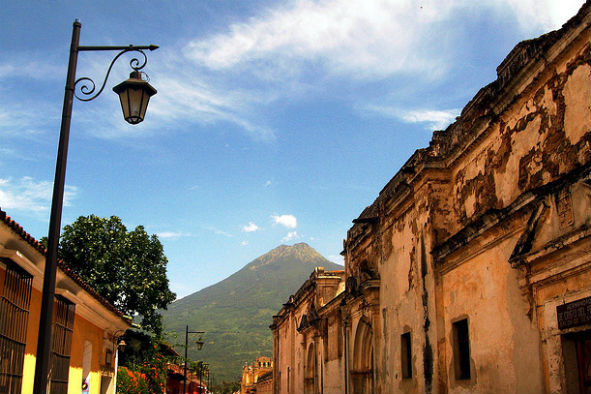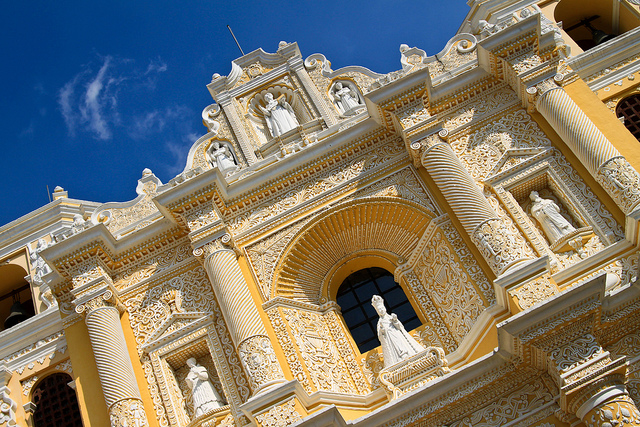Following a lengthy civil war in Guatemala, tourism to Antigua has proven to be one of the enduring economic casualties. To this day visitors arrive in a mere trickle, but the shadows of the past have long since dissipated and Antigua is proving to be a remarkable destination.

A volcano at the end of the street, Antigua, Guatemala. (Photo: M. Swigart via Flickr)
Guatemala is a land layered with intricacy. Just over a decade ago, the country was in the throes of a protracted civil war that lasted three decades, and although the war is now over, lingering doubt has thus far kept mass tourism at bay, sheltering Guatemala from the kinds of resort-based settlements that have sprung up in neighbouring Mexico.
For now, it is a blessing in disguise because those intrepid few who do dare to venture get to discover Antigua; a starlet waiting patiently in the wings ready to capture the hearts and minds of all who visit.
Antigua’s appeal spans centuries, tracing back to a time when the Spanish arrived, waved a wand of Colonial charm over the city and crowned Antigua Spanish Capital of Central America.
At its height, Antigua thrived, but as Guatemala’s tumultuous history would dictate, it wasn’t long before misfortune took its turn. Swaddled in a landscape that is dominated by voluptuous volcanoes, Antigua was shaken to its knees by an earthquake that ripped at the seams of the land in 1773 that all but destroyed this Colonial town.
Reduced to rubble, there was little option but to shift the Capital to what is now the sprawling mass of Guatemala City. Civil war later set in, trading ceased, a state of emergency endured and for a long time Guatemala was lost to the tourist map.
However, if history has proven anything, it’s that Guatemala is a robust country and with the civil war now behind it, the country is ready to move on, with Antigua providing the finest incentive to visit. Thick with history, thriving with possibility and overflowing with tangible beauty, logic dictates that it is only time that will keep Antigua from the tourist masses.
A UNESCO World Heritage Site
Flanked on three sides by the dense grey volcanic peaks of Agua, Fuego and Acatenango, the town’s backdrop is haltingly dramatic. As white nimbus clouds float dreamily past, barely reaching the volcanoes’ midriffs, it’s tempting to never look anywhere other than the horizon. However, to fixate on the volcanoes would be to miss the vivid palette of colors that is laid out around the town. From the architecture that gleams in shades of golden maize and sunshine ochre to the market complete with a rainbow of fruits and vegetables to the vividly alluring fabrics and cloths worn by the local people, Antigua’s colours provide the perfect contrast.
Beyond the town’s myriad hues, Antigua holds a cultural concoction that justly deserves its UNESCO World Heritage Site status. While much of the town was sympathetically restored to its former grandeur following the devastating earthquake of 1773, a few tumbling remnants of the town’s Colonial past have been left where they fell, cautiously preserved, accentuated by lilac flowering Jacaranda and providing the gift of a visually commanding and historically fascinating legacy.
Parque Central sits at Antigua’s heart and is skirted by Catedral de Santiago with its baroque interior and the Palacio de los Capitanes Generales (Captain-Generals’ Palace) with its double-arcade façade. However, it is the dense saturation of churches and monasteries that is perhaps most compelling. La Merced is particularly adept at capturing visitors’ imaginations with its tangle of ruins littered behind a pastel yellow and white stucco façade. Las Capuchinas is equally noteworthy for its distinctive circular cells that were once home to the monastery’s nuns.
Around the City
Beyond the town’s architecture, horseback riding and cycling tours are popular thanks to the drama of the volcanoes serving as scenery. And for those brave enough to ascend and peer into a crater, volcano climbing also tops many visitors’ lists. However, it is far from necessary to hike the volcanoes to enjoy the pleasure of their presence. An abundance of naturally occurring thermal pools surround Antigua and many have been given the luxury touch.
Antigua’s cultural immersion credentials are also strong – spend time learning the art of Guatemalan cooking, get to grips with the local language (Spanish or Mayan) or take to your toes and master the performance of salsa or merengue. But perhaps one of the most fascinating insights into local life can be found in a visit to a local finca (farm) where the avocados, macadamia nuts and coffee beans receives plaudits as Guatemala’s finest agricultural achievements.
When it comes to resting your head, Antigua knows how to indulge its visitors. El Convento, which fronts Antigua’s 18th century Capuchin convent, is an all-suite boutique hotel that fuses Colonial tradition with Guatemalan style while Palacio de Doña Leonor provides is an elegant option located in a former Colonial palace.
As dusk rolls around each day, adding deep blues to Antigua’s color palette, Guatemala’s finest flavours can be found. Fresh from the market, rich in spices and served with an abundance of hand-shaped tamales, the town’s restaurants put on an excellent show. The local specialty, pepián y pollo, comprises chicken served in recado, a sauce similar to Mexican mole that is so complex it will leave you guessing the combination of spices long after the last bite has been swallowed.
It’s possible to dedicate a lifetime, let alone a short visit, contemplating the complexities that lie in the history and culture that is Antiguan life. While you may never come to understand them entirely, you’ll certainly be glad you tried.
